There is a certain poetic irony laced in the earnest beauty of the shared human experience regarding the fact that cemeteries have been amongst the few places some of us have felt comfortable (or been permitted by law) to visit since the pandemic began.
Cemeteries and graveyards in some parts of the world have been closed to the general public during these highly challenging times, but many have remained open – frequently with Covid safety measures in place.
As a passionate taphophile, I have been visiting cemeteries since my youth. These sacred spots of eternal slumber are amongst the most serene, comforting, enjoyable, inspiring, and beautiful I have ever known.
Another irony is that cemeteries often make me feel more alive. They conjure all manner of thoughts and emotions pertaining to death, as well as to the gift of life.
Cemeteries are not amusement parks, and while there is no shame at all in feeling happy or content at a cemetery, it is important to always remember the somberness and loss they signify for many on this side of the veil who have endured the passing of a loved one.
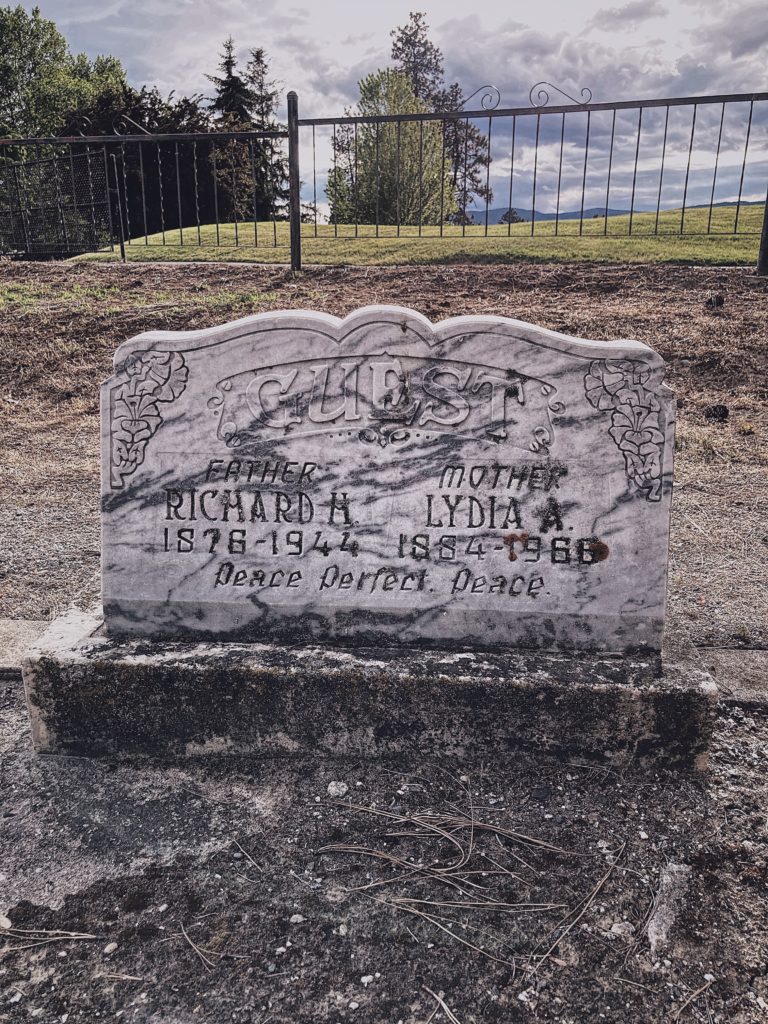
When I spend time at a cemetery, I make a point to reflect not only on the lives of those interred there, but also on the impact their passing may have had on those who knew and cared about them.
Not everyone who dies is buried or interred in a cemetery or graveyard. Yet, no matter our final resting place, we are all connected from the very first human to the last who will ever exist by the unifying certainty that is death.
Visiting cemeteries outside of reasons such as funerals, genealogical or historical research is not everyone’s cup of tea.
I acknowledge and respect this fact. We are each different, each called to by various places and passions throughout our life.
Whether you define yourself as a taphophile or not, if you have even an inkling of an interest in graveyards, cemeteries, and the like, I hope will enjoy a new periodically occurring post series here in which I take you along with me as I explore (and sometimes reexplore) cemeteries that I have visited in person.
I am dubbing this post series “Cemetery Journeys”.
This name is both literal in the sense of that it will document trips/journeys to various cemeteries around Canada (and who knows, perhaps further afield, too 😃), as well as being a respectful homage to the fact that, ultimately, we are all on a journey to the grave.
Launching a series like this is something I have been keen to do since Witchcrafted Life began last year.
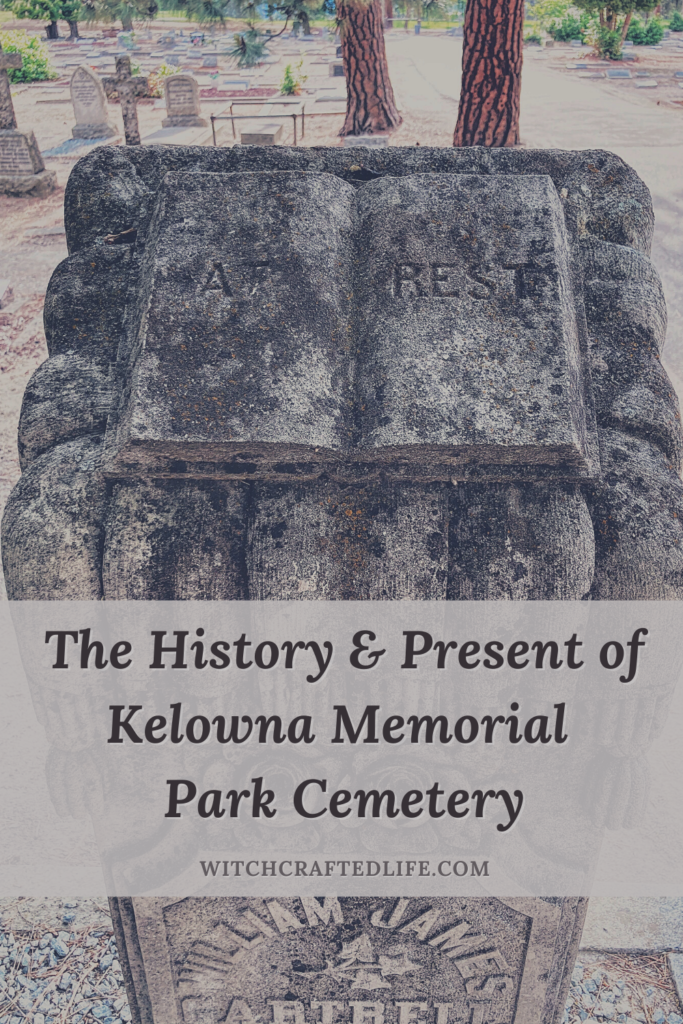
Now (with the first harvest sabbat of Lammas under our belts and the exciting journey towards fall, Mabon, and Samhain upon us) seemed like the ideal time to do so. And what better cemetery to begin with than one from our very own region of British Columbia: the Kelowna Memorial Park Cemetery.
But first…
An extremely brief history of Kelowna, British Columbia
As the largest city in this province outside of the Lower Mainland area of British Columbia, it is only natural that Kelowna serves as a hub for the valley – called the Okanagan Valley – in which it resides. Doing so, quite conveniently, in the center of this region.
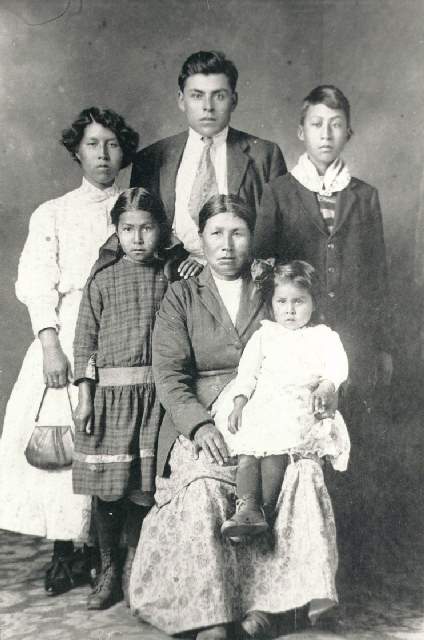
Many thousands of years before the earliest Europeans set foot on the arid soil of the sun-drenched Okanagan Valley, the area was inhabited by the Sylix/Okanagan People.
This part of BC was not entirely unknown to Europeans – chiefly those involved with the fur trade in Western Canada – in the 18th and early 19th centuries. However, it was not until 1859 that the first non-First Nations settlement was established in Kelowna.
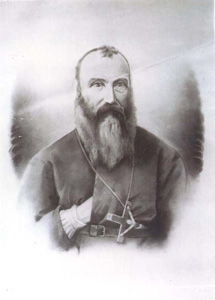
This effort was led by a man whose name is now embedded in the area and who is still spoken of affectionately to this day by generations who never got the chance to met him: Father Pandosy.
Two other Oblate missionaries, Father Richard and Brother Surel, respectively, also had key roles in establishing a mission in what would one day become the city of Kelowna.
The formation of this mission helped to entice settlers from elsewhere in the province, country, and further afield to the budding community. Following that, it wasn’t too long before Kelowna’s roots as a city were firmly planted.

As the century began to tapper, Kelowna got a further boon when in 1893 the Governor-General of Canada, Lord Aberdeen, purchased a substantial amount of land in the area. Much of this land would be used for orchards, which did a great deal to bolster the area’s economy (the Okanagan Valley in general is one of North America’s largest fruit and viticulture growing centers).
As the 20th century emerged, Kelowna’s population continued to be on the smaller side of things, sitting at about 600 inhabitants. However, that was still enough to land Kelowna status as a city in 1905.
The name Kelowna derives from an Okanagan First Nation word for grizzly bear. A majestic creature that feels like an especially fitting animal to associate with a city nestled in the heart of a wild, desert-like landscape that is famed for its breathtaking nature beauty.In the days before roads, highways, and even railways, snaked their way to the Okanagan, much of the traffic to and from Kelowna was carried out via sternwheeler boats that plied the abundant waters of Okanagan Lake.
With mining thriving in various parts of Central and Northern BC during the early 20th century, it wasn’t long before the Canadian Pacific Railway came calling.

A touch east of Kelowna, track was laid across a beautiful chasm called Myra Canyon. From the years spanning 1916 to 1972, CPR trains traversed Myra Canyon and in doing so, helped to open up the area, bolster its economy, and put Kelowna on the map all the more.
These days, Kelowna has a population of just over 132,000 people.
Compared to many cities around the world, that might seem fairly small. However, for a province that only been inhabited by European (and other international) settlers for about two centuries now, Kelowna is quite a decent size.
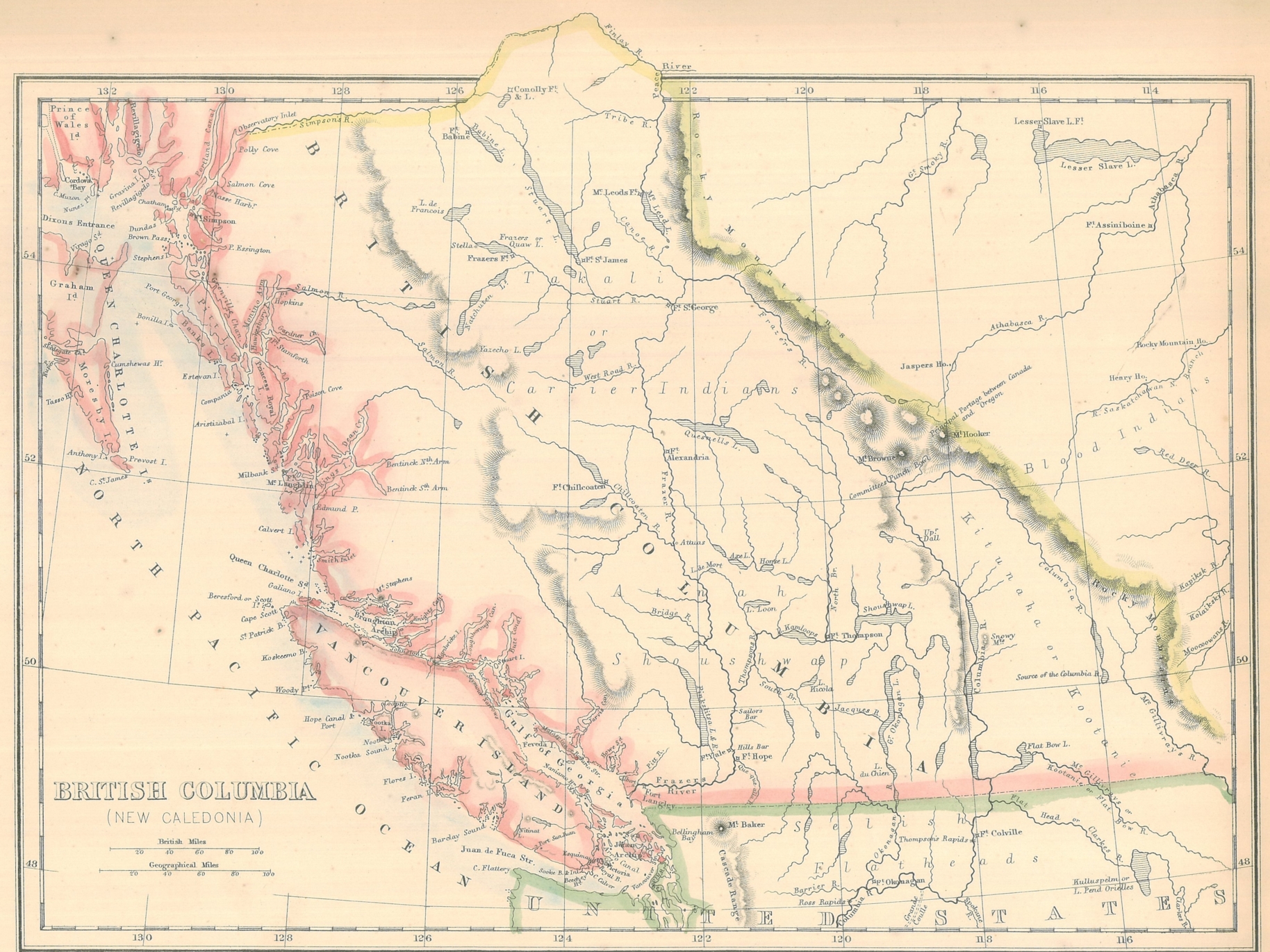
Indeed, many corners of BC were not established (as the towns and cities that they are now) until the late 1800s or early 1900s.
As such, the fact that Kelowna got its start in the mid-Victorian era helps to make it one of the oldest continually settled corners of the province – especially north of the Fraser Valley/Lower Mainland area of the province. (The first white settlement in British Columbia was established in the 1790s at Fort St. John in northeastern BC.)

Naturally, as with most communities, it did not take too long for Kelowna to require, and in turn construct, a cemetery of its own.
Kelowna has had, and continues to have, various cemeteries throughout its lifetime. In this post, we are going to explore the largest of them, the Kelowna Memorial Park Cemetery.
Kelowna Memorial Park Cemetery
Located at 1991 Bernard Avenue in Kelowna, British Columbia, the Kelowna Memorial Park Cemetary spans a rolling, beautiful 50-acre space at the foot of Dilworth Mountain. It is immediately adjacent to the Kelowna Golf & Country Club, and the relative serenity of both make them well-suited neighbours.
For those wishing to visit, the Kelowna Memorial Park Cemetery is open 365 days a year from 7 am – 8 pm between March 16th and October 31st, and from 7 am to 5 pm from November 1st to March 15th.
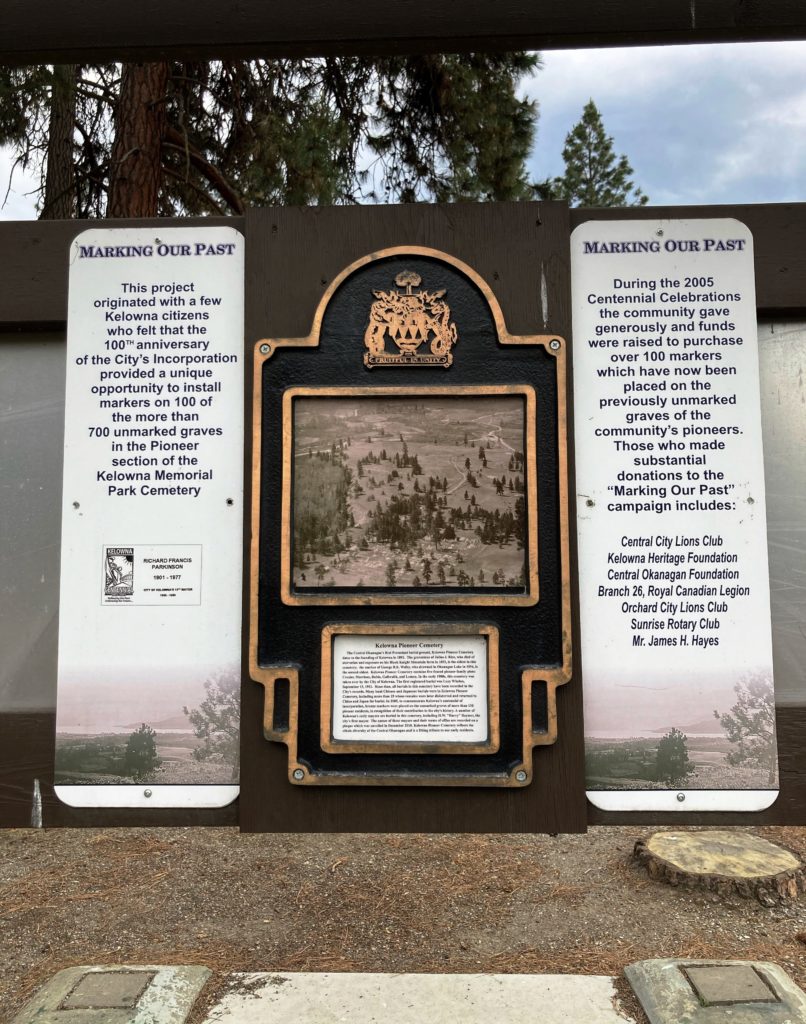
At various points in the year, Kelowna Museums offers reasonably priced guided tours that focus on a particular aspect of the cemetery’s, and by extension Kelowna as a whole’s, history.
This summer’s tour is “Kelowna’s Forgotten Chinatown”, led by local historian Bob Hayes.
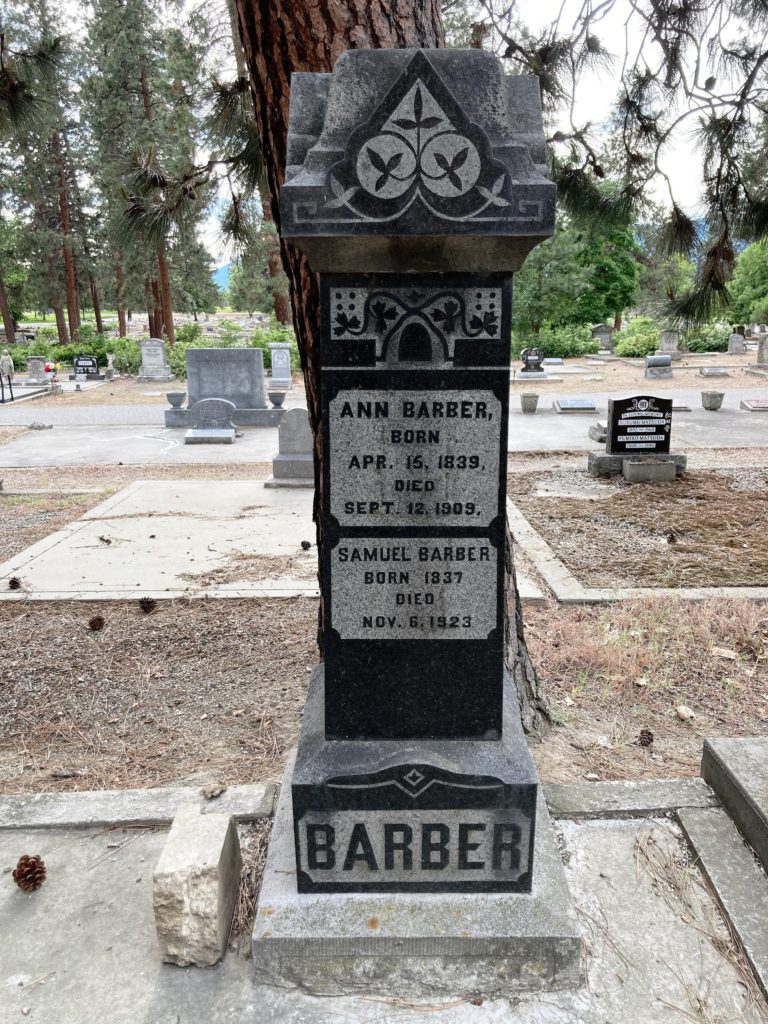
Kelowna Memorial Park Cemetery got its start as an Anglican Church burial ground at the turn of the last century, blossoming in the ensuing decades into a sprawling multi-cultural, historically rich cemetery with, at present, more than 25,000 memorials.
A cursory glance of the grounds that comprise the Kelowna Memorial Park Cemetery can be a touch deceiving. At first sight, the cemetery may not seem as large as one might expect for a city the size of Kelowna.
However, it takes but a few minutes (especially if they’re spent on foot) to quickly realize that this is anything but a small cemetery.
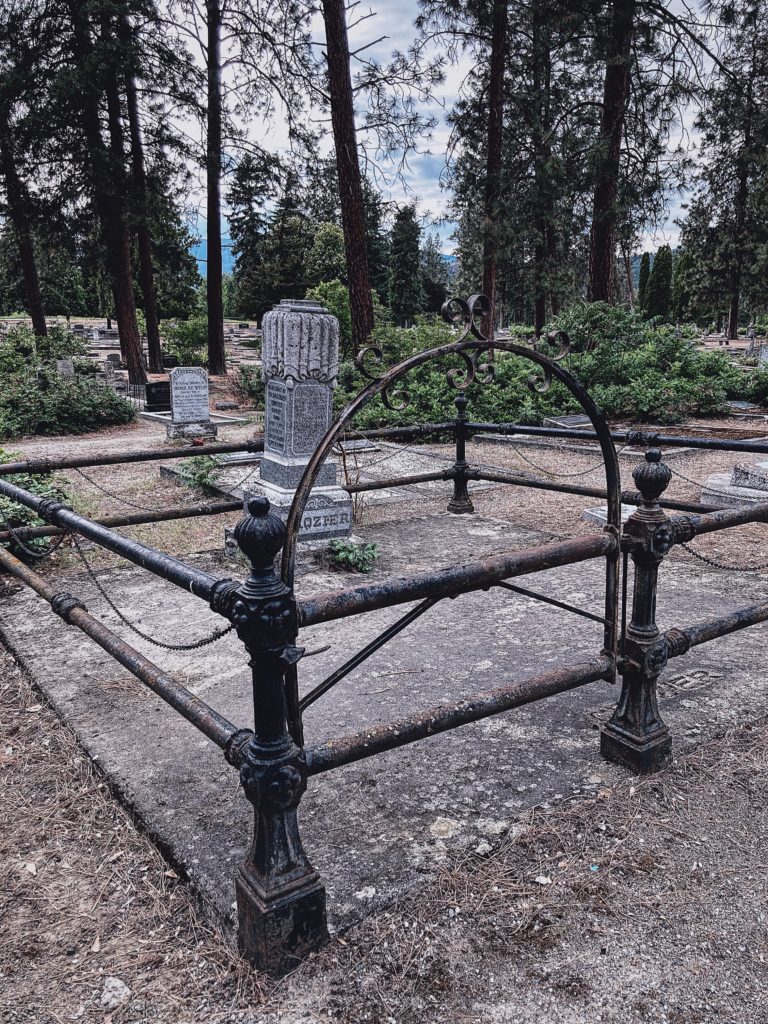
Fifry acres is nothing to sneeze at and while it is certainly possible for one to traverse the whole of Kelowna Memorial Park Cemetery in a single (good-sized) visit, you may wish to split seeing the entire cemetery across multiple days.
That has been my approach. Done both because of the size of this burial ground and because I truly like to take my time and connect with each cemetery, and its inhabitants, that I have the joy of visiting.
Cemeteries in British Columbia, Canada
As it is safe to say that most of the cemeteries that I highlight here in this engaging new blog post series are apt to be ones located in British Columbia (where I live), we should touch on some points about cemeteries in BC in general before proceeding further.
As a collective whole, Canada is, from a non-First Nations Peoples standpoint, a very young country.
We officially became a nation in 1867, though our non-indigenous history stretches back a few hundred years earlier. Nevertheless, we’re a relative newcomer on the world stage compared to many other countries and this fact is reflected in Canada’s cemeteries.
Extremely few Canadian cemeteries proceed the mid-1700s and many are far newer still, having been established in the 19th or 20th centuries. (An unmarked burial site in the Maritime province of Nova Scotia is believed to house European settler graves that may date back to around the 1680s.)
Prior to the mid-nineteenth century, the vast majority of Canada’s European population was located on the Eastern side of the country – which still houses the largest portion of this nation’s inhabitants.

Gradually, western expansion and exploration unfolded. From the long treks of a small number of intrepid adventurers, hearty explorers, and fortune seekers alike, followed waves of more what might be termed more generalized migration to British Columbia.
With a shoreline nestled against the mighty Pacific Ocean, British Columbia is Canada’s most westerly province.
Before the days of planes, trains, and automobiles, it could only be reached by water travel or a lengthy overland journey which often encompassed crossing the formidable Rocky Mountains.

As a land of diverse climates, ample opportunities, and staggering natural beauty, once the western expansion ball got rolling, it didn’t take too long for BC to flourish.
New communities, towns, and cities alike sprang up rapidly through various parts of the province during the 19th and early 20th centuries.
Some – particularly when mining was involved – were relatively short-lived. Plenty though were able to not only survive, but thrive, and now account for why BC is Canada’s third most populous province.

While no shortage of fortunes were made (and plenty lost) in BC’s early days, by and large, the population that settled here was comprised of hardworking everyday folks eking out a living, building families and community ties, and helping to turn this province into the wonderful place that it is today.
What, you may be asking, does this have to do with the Kelowna Memorial Park Cemetery and BC’s cemeteries in general?
The answer lies in the relative humbleness and understated designs of the grave markers and other memorial elements that comprise most cemeteries in British Columbia (and to a degree, throughout much of Canada in general) – as well as the size of the cemeteries themselves.
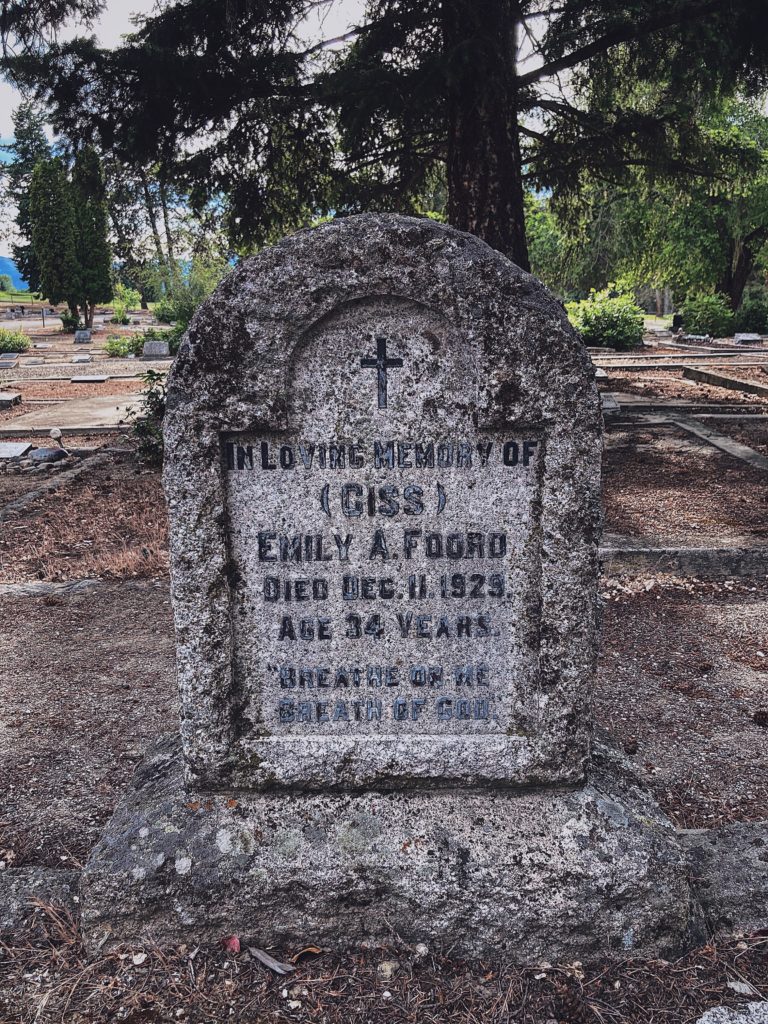
Are there exceptions to that statement? Absolutely! One need only look, for example, to Mountain View Cemetery in Vancouver or Ross Bay Cemetery in Victoria to see expansive cemeteries that include an array of more ornate memorials. Many of which date to the Victorian and Edwardian eras.
However, as a whole, BC’s cemeteries are humble affairs. Few teem with the iconic colonial-era headstones of some of the graveyards in the Eastern United States or the jaw-dropping artistry and grandeur of cemeteries such as Kensal Green and Highgate in London, England.
Yet, even so, it is safe to say that each of British Columbia’s cemeteries has a heartwarmingly enduring beauty all its own.
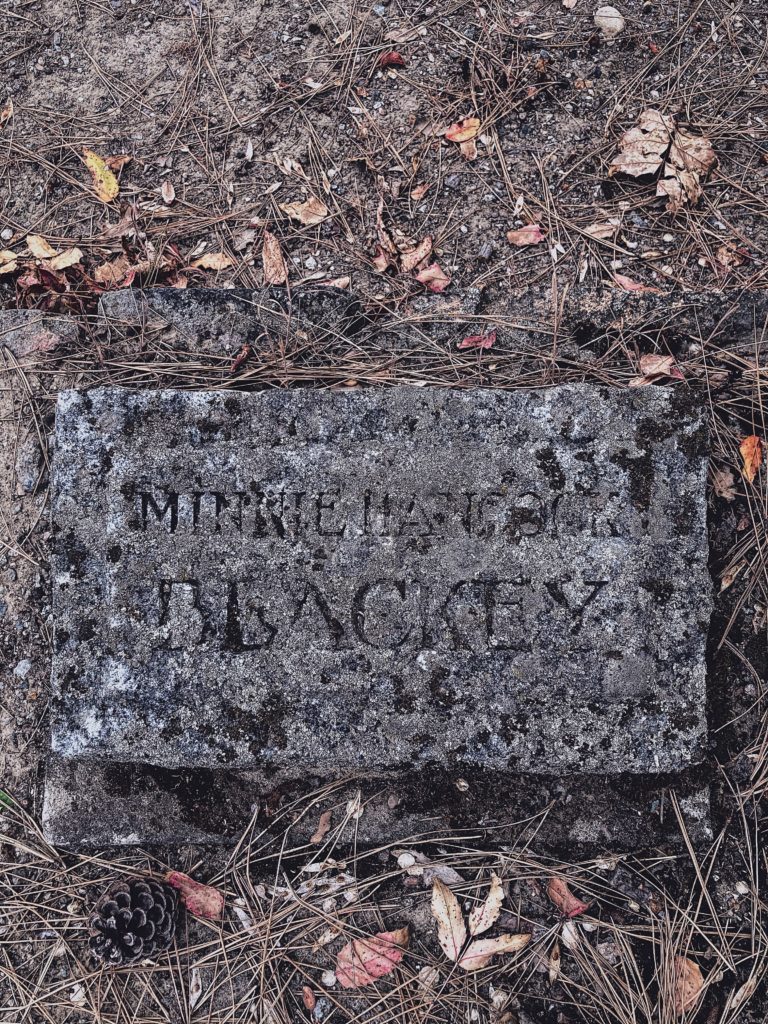
They, like most cemeteries and graveyards the world over, also rarely lack for history – whether that past can quickly be learned about in books, museums, and online or if much of it has now been enveloped by the murky ethers of time.
A springtime visit to Kelowna Memorial Cemetery
On one of those mid-spring days when the weather has more sides to it than an octagon, my husband, Tony, and I decided to spend an enjoyable afternoon visiting the Kelowna Memorial Cemetery.
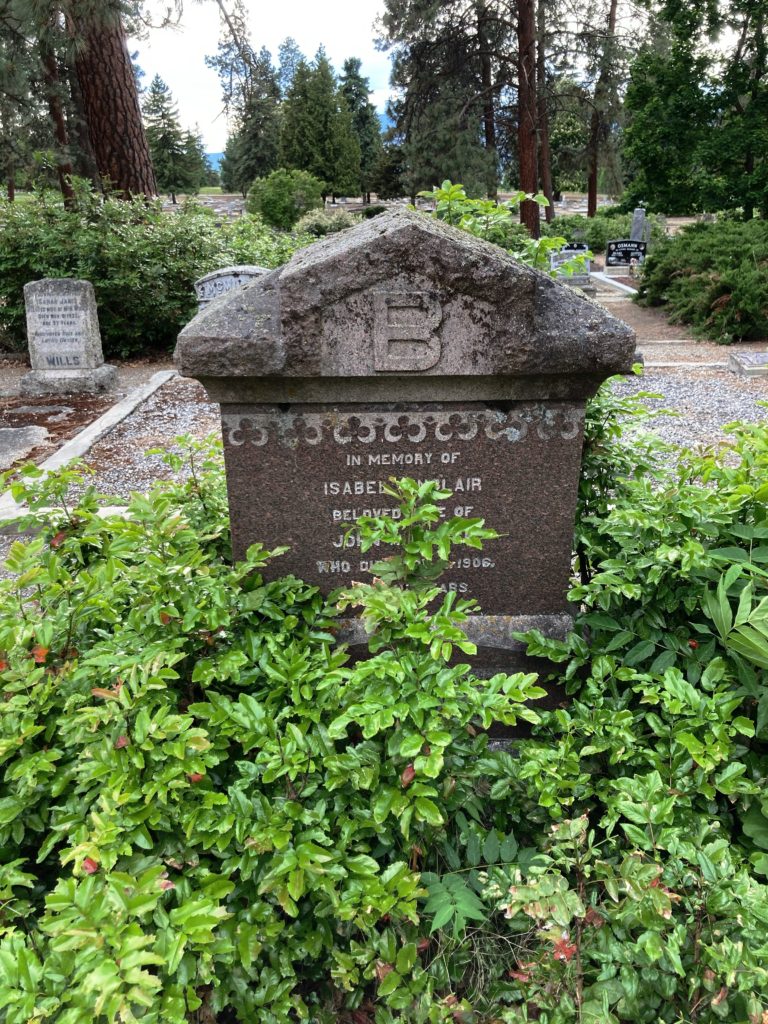
Covid rules were (and still are at the time of writing) in place and we made sure to respect them fully.
Despite the relatively mild weather that was flip-flopping from overcast to briefly sunny and back again, we saw almost no other visitors to the grounds the whole time we were there.
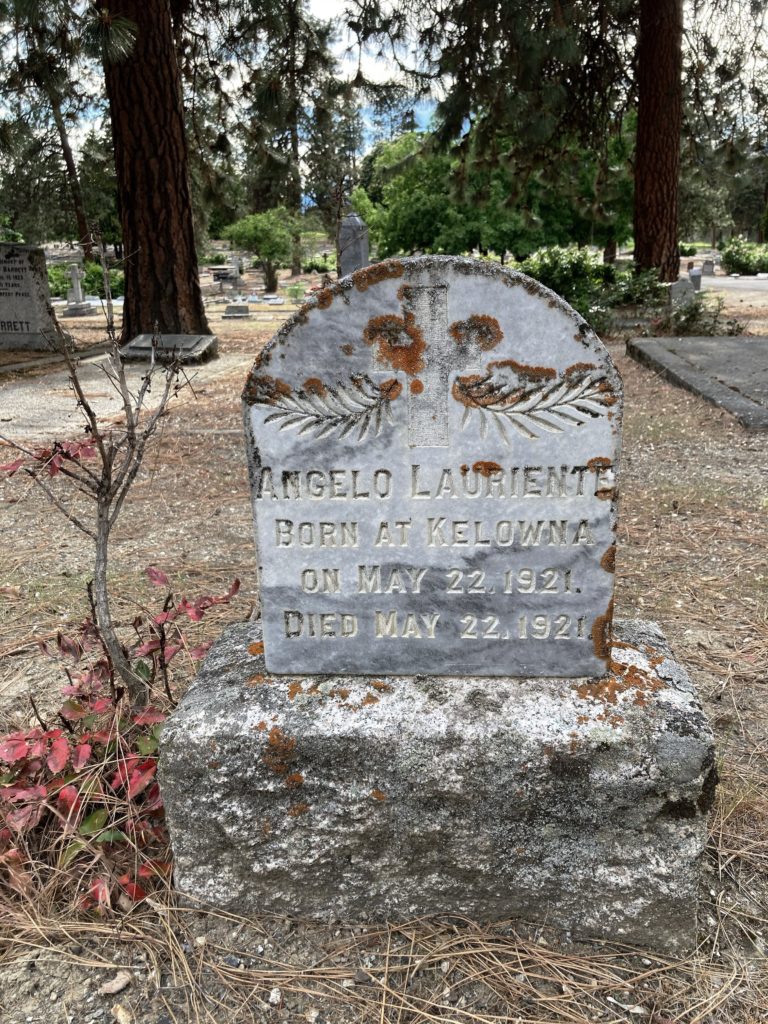
That isn’t to say that there weren’t potentially some there. Simply that the vastness of the 50 acres of this cemetery easily allowed us to walk for hours without encountering another living soul on that particular day.
Our visit was a general one. We didn’t come with any specific goal or research purpose in mind.
This outing was about shaking off some of the cabin fever of winter, spending time getting to know the Kelowna Memorial Park Cemetery (which is located just over an hour’s drive south of our small town) better, and taking photos of some of the graves and other structures on the premise.
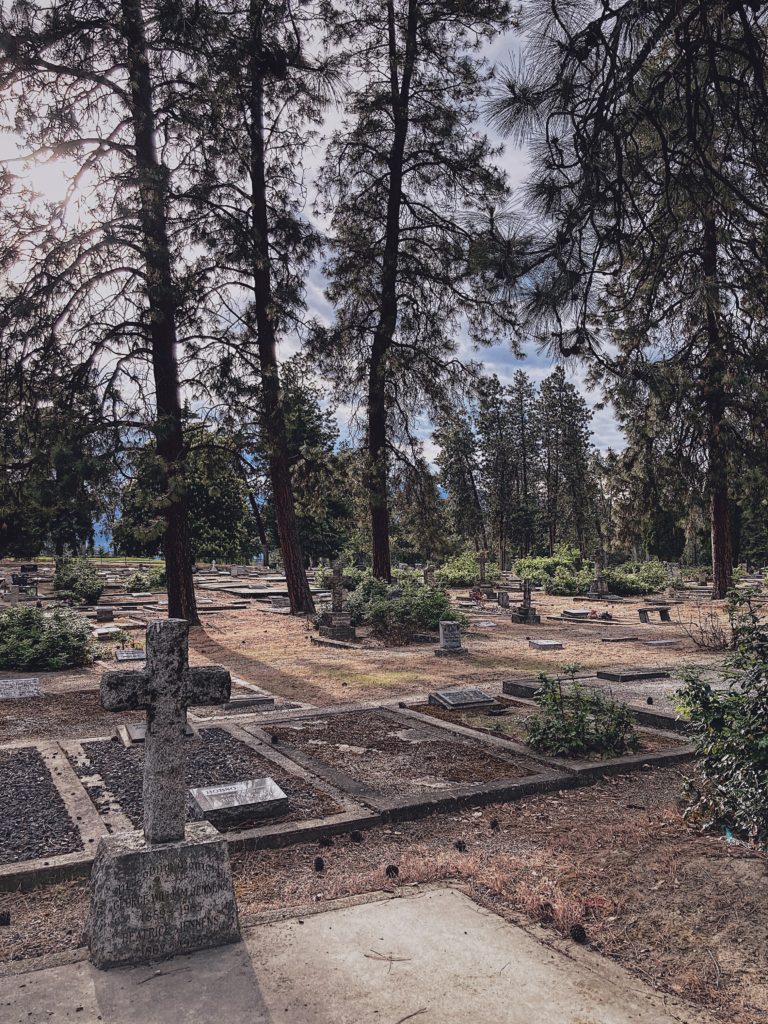
Many a headstone and grave marker calls the Kelowna Memorial Cemetery home. In addition, cremations are housed in cremation niches, crypts, and columbaries, particularly in a part of the cemetery called the Legacy Gardens.
Like a lot of taphophiles and graveyard adventurers (though not all, of course), I find myself – a lifelong lover and student of history – drawn to older graves.
Thankfully, Kelowna Memorial Park Cemetery is happy to oblige those with a passion for the past. Various portions of the cemetery are divided into lettered sections, with the first, Section A (also known as the Pioneer Section), being dedicated to some of the oldest inhabitants.
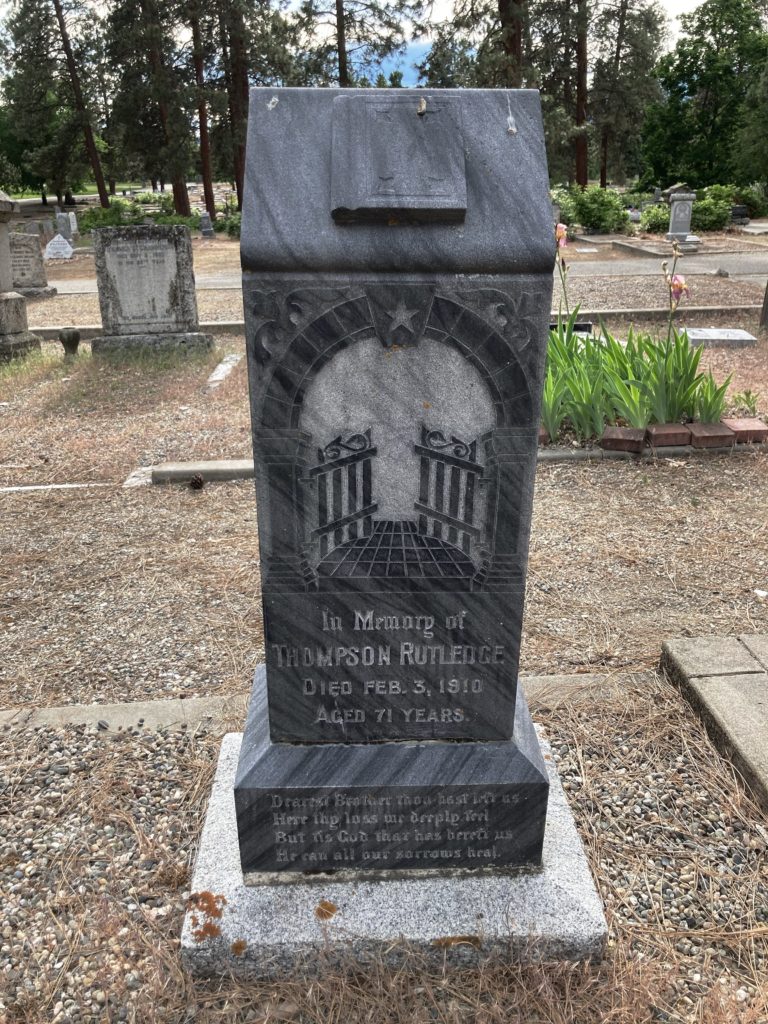
Amongst which various founders of Kelowna are laid to rest, including a chap named Bernard Lequime who, in the 1890s, laid out the original townsite of Kelowna, and Arthur Booth Knox, after whom Kelowna’s gorgeous and highly visited Knox Mountain is named.
The Kelowna Memorial Park Cemetery also houses areas specifically dedicated to both early Chinese and Japanese citizens as well.
In 2014 a granite monument was erected in the Pioneer Section on behalf of the BC Legislative Assembly to acknowledge the wrongdoings done against many early Chinese Canadians by past provincial governments.
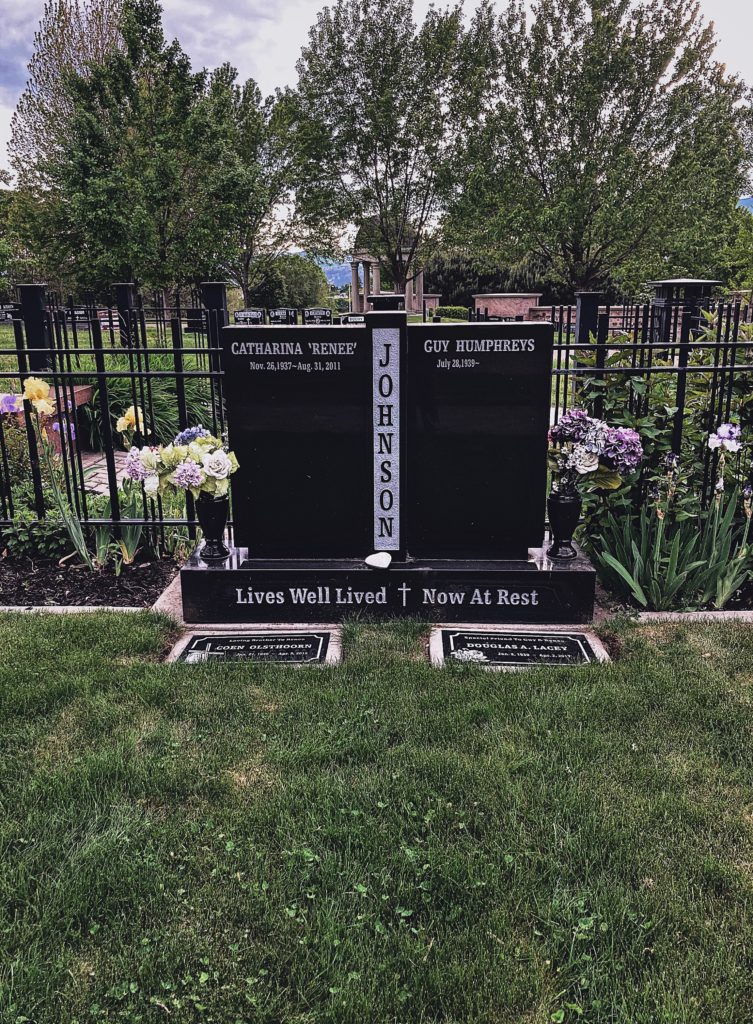
Many more recent graves also call this cemetery home, as do an abundance of tranquilly lovely trees and many gorgeous, well-manicured flowerbeds.
As with plenty of cemeteries (of all sizes), the grave markers at the Kelowna Memorial Park Cemetery are in varying conditions. Quite a few are presently holding up well for their age, whereas others have succumbed to the ravages of time, moss, and weather conditions.
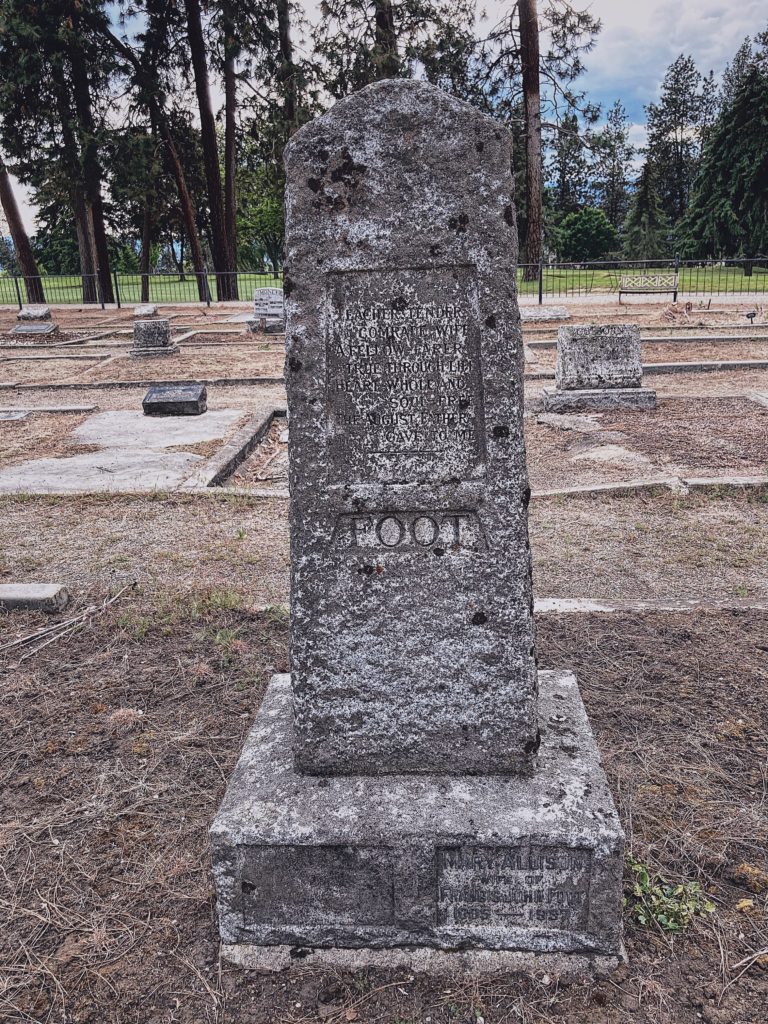
In general, though, I find a good percentage of the older tombstones to still be fairly legible. Some are nearly as crisp as the day they were first etched, others are clearly showing their age, but (again) remain readable.
On this visit, we did not see the whole of the cemetery – nor did we make a point to inspect every single grave in each area that we did spend time in.
Both Tony (a fellow taphophile) and I love to have more to explore and acquaint ourselves with further on future visits.
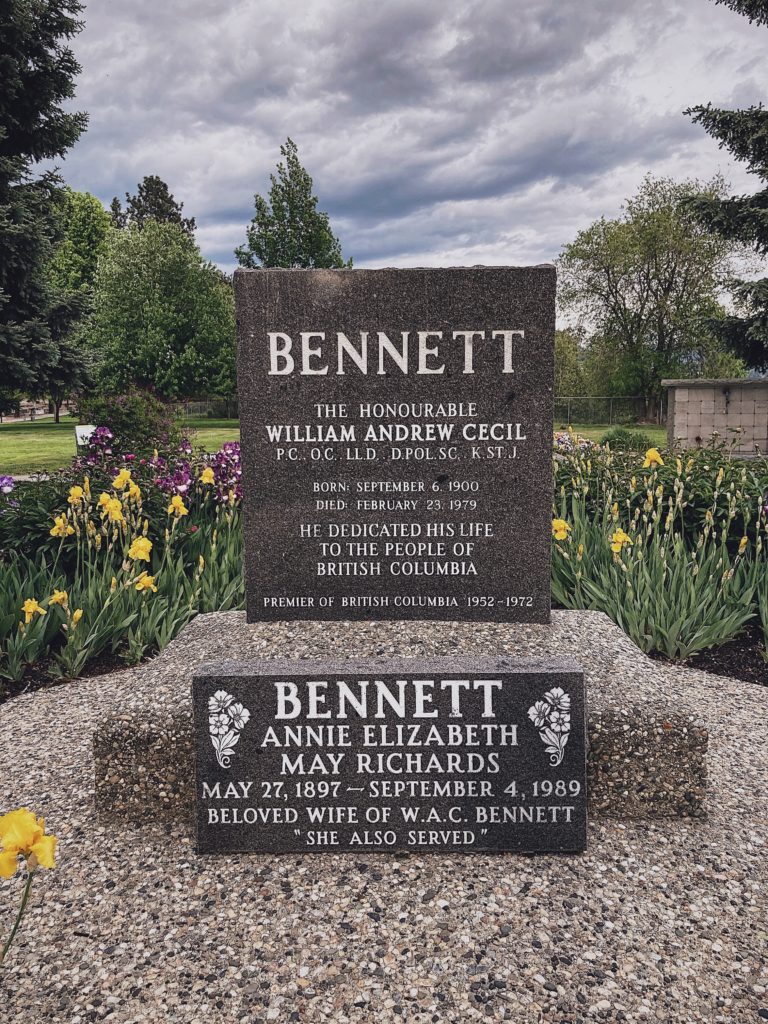
No post pertaining to the Kelowna Memorial Park Cemetery worth its salt would be complete without mentioning some of this burial ground’s best-known inhabitants: various members of the Bennett family, including the famously outspoken former BC Premier W.A.C Bennett and his wife, May.
Both are interred at this cemetery and in addition, the Bennett Memorial Columbaria provides above-ground monuments for the placement of private cremation remains (totalling 576 cremation niches, each of which is able to house two urns).
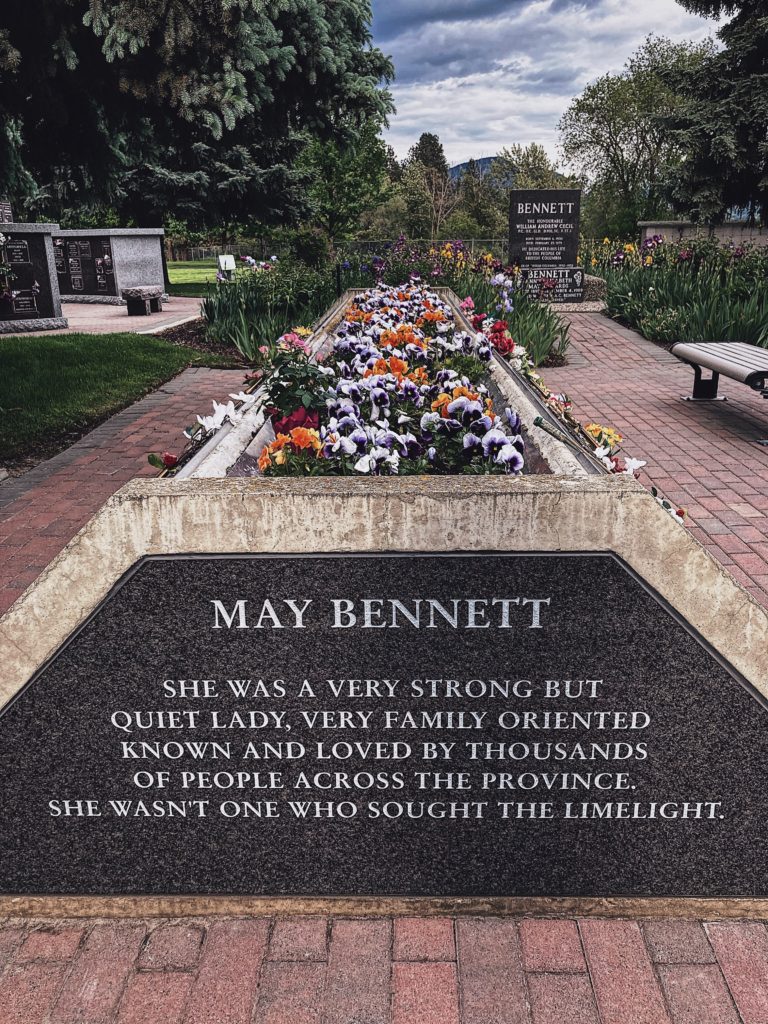
There is much more to see and explore at the Kelowna Memorial Park Cemetery beyond what appears in this post.
I hope to photograph and share additional parts of it with you in future editions of this series (as well as on my Instagram account, where I’ve been posting photos from various cemeteries for a number of years now).
This cemetery is a beautiful, well-maintained, peaceful, inspiring, and enjoyable one. I feel at ease there and love that it, like most of the cemeteries that I have the honour of visiting, resonates deeply with my spirituality as a Pagan witch.
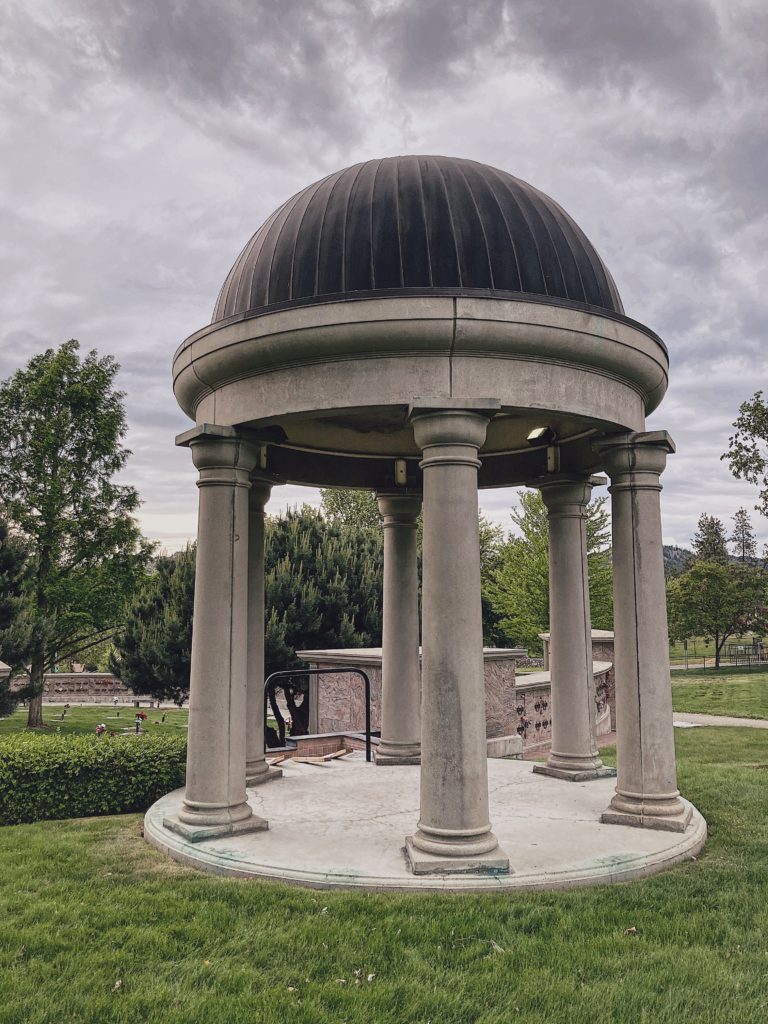
If you should have the opportunity to visit the Kelowna Memorial Cemetery, I highly recommend doing so.
At 50 acres and more than 25,000 final resting places (be they graves, urns, scattered ashes, or memorials without actual remains), this historically rich corner of Kelowna is one that is sure to appeal to taphophiles, history buffs, genealogists, and many a goth soul alike.
Not to mention those who find solace and comfort in cemeteries.
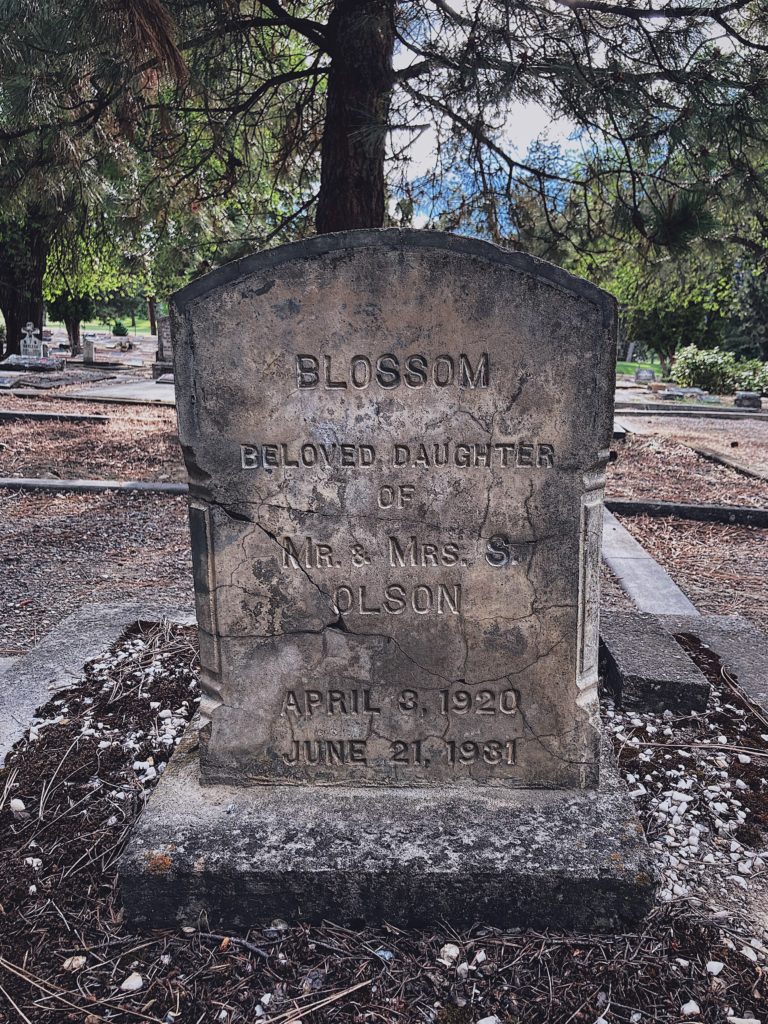
I fall into every one of those camps myself and am excited to hopefully share many more cemeteries journeys around BC (and hopefully elsewhere as well) that I have the pleasure of undertaking. (Pun intended, sentiment no less sincere.)
Have you ever been to the Kelowna Memorial Park Cemetery? What was the last cemetery or graveyard you visited? 🥀🖤🥀

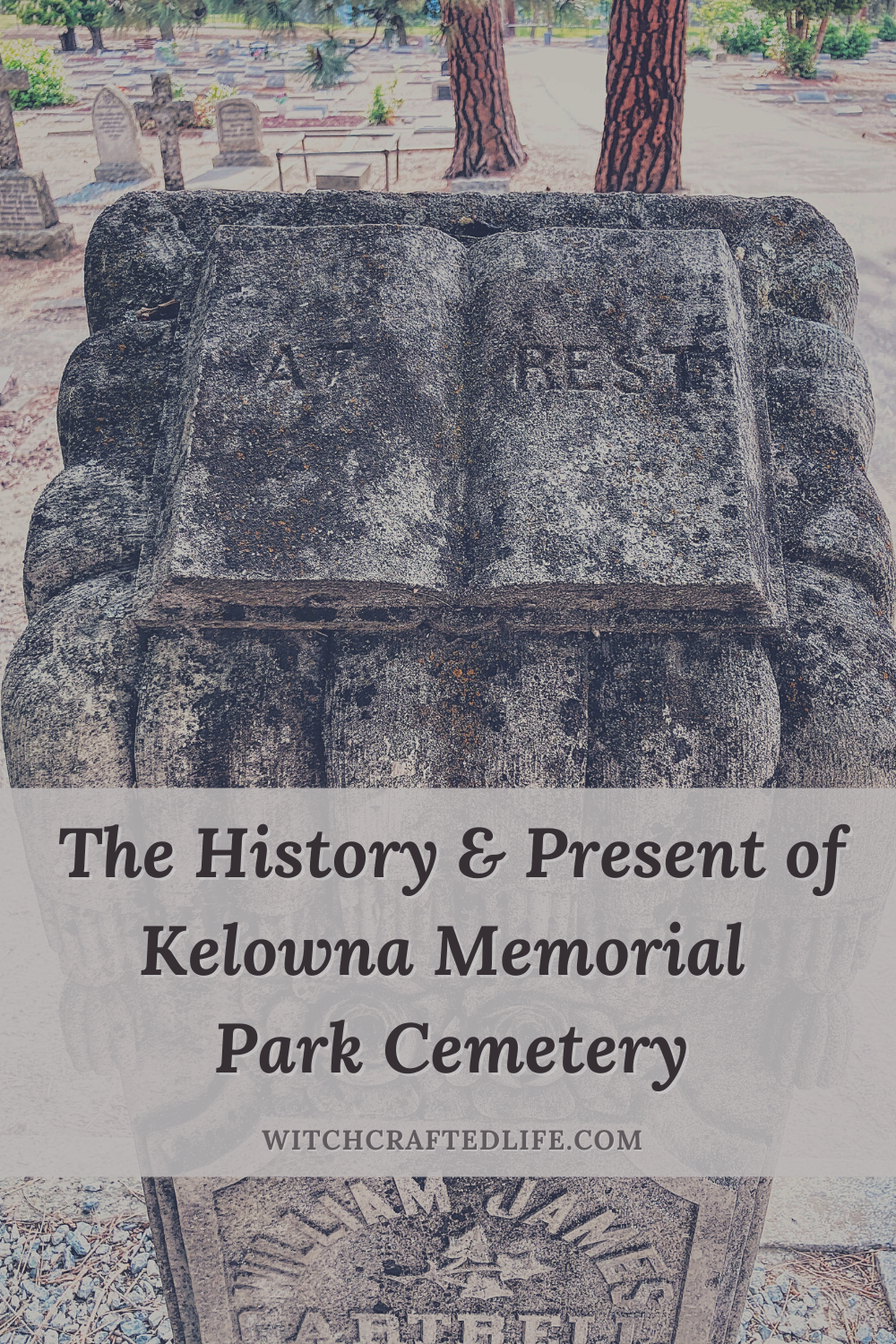
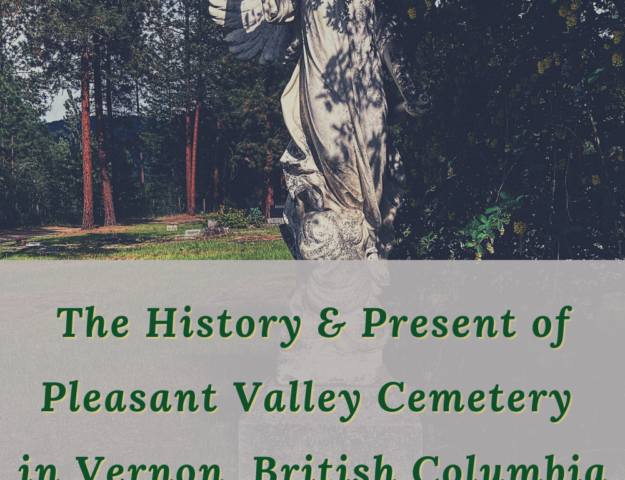
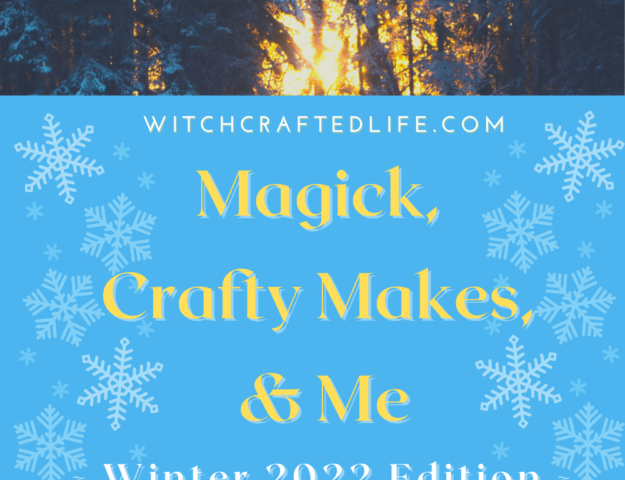
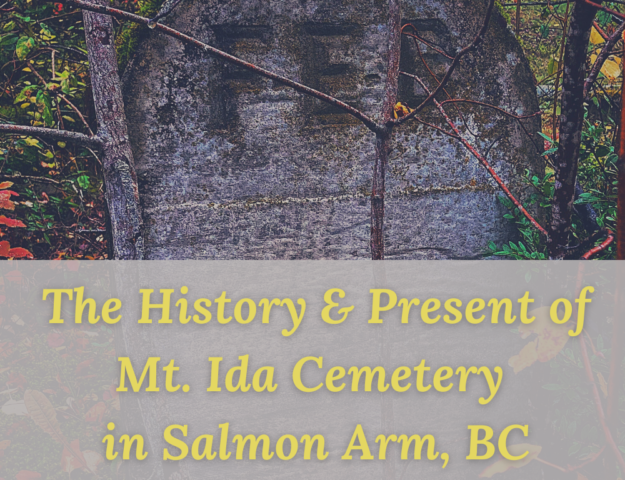
An amazing history lesson from your visit to the cemetery, great idea! We used to do this as kids.
Thank you tremendously, dear Donna. History is one of my greatest passions in life. For several years (2009 – 2017) I ran a blog that primarily focused on mid-twentieth century history and fashion, and greatly miss writing more frequently on historical subjects.
To that end, I’m making a conscious effort to do so more more often here on my current site. Posts like this exciting new cemetery exploration series should go a decent way to help on that front.
If there’s ever a historical topic you’d be keen to see me discuss here, please don’t hesitate to let me know.
Many thanks again & have a wonderfully lovely first week of September,
🖤 Autumn
I love this article. The history surrounding cemeteries has always interested me. You have inspired me to try this myself.
What a wonderfully kind and encouraging comment, sweet Debi. Thank you very much. It warms my heart to know that this post has helped to spur you on in the exploration of burial grounds in your area.
If all goes to plan, my mom, husband, and I will be going on a road trip to a very pretty little town a few hour’s drive away next month. While there, visiting (and photographing) as many cemeteries in the area as I possibly can will be at the very top of my agenda (hopefully with blog posts on them to follow in the months ahead). 😃
🖤 Autumn
Wonderful post. I share your love of cemeteries and have been visiting more as I’ve gotten older. They stimulate me to think about past lives and mortality. Plus, they’re usually beautiful. Great pictures here.
This is uncanny – we have been visiting a new to us cemetery 40 minutes away in a heritage site little known. It had graves dating back to 1779 which is early here and also some native/ aboriginal graves ( my grandpa is aboriginal/ Spanish descent so I treasure that a lot ) it’s a gorgeous little tiny Anglican Church and grave – I was going to post pictures in my next post! Serendipity! You will love it !!! If you ever come this way I will show you !
Kelowna is a home away from home for us in our twenties – my aunt died there but her ashes were actually dispersed at the Headwaters Camp lake she ran and loved.
That cemetery is gorgeous and I loved all your history and that you included the diversity that has always been here and made direct impacts on our history – too many are forgetting the positive stories and also the travesties against Asian and Aboroginals groups – we need to include everything within context in our remembrance- we are less prone to blame or nostalgic the past but instead see it like today – full of paradoxes, good and bad, people fighting to be legit in their times, and carving their best lives in struggle and thriving – I love this!
Thanks for adding beauty to the world .
Thank you very much for your wonderful comment, sweet soul, and for sharing with me about the “off the beaten path” historical cemetery that you’re fortunate to have so close to where you live. I was not aware of any cemeteries dating that far back in Alberta – you’ve given me even more motivation now to make it back to that gorgeous province ASAP (I utterly and completely adorable Alberta, and had the pleasure of living there for a couple of years in my late teens; visits back have been plentiful since, though less so, naturally, since the pandemic struck and put the breaks on our usual road trips throughout Western Canada).
Excellently and very compassionately said regarding the importance of neither looking at the past with rose coloured glasses nor forgetting the context of the time in which past generations lived. I very much concur and try to maintain a fair and factual approach to writing about historic topics of all kinds, remembering as I do that so that, in many cases, there were more individuals than just those whose name made it into the history books involved with life (and death) in a given area.
I sincerely appreciate your touching offer and will not hesitate to take you up on it one day. Likewise, if you’re out this way and want to do so some cemetery exploration together, just say the word.
Big hugs & the sunniest of wishes for a relaxing, beautiful September.
🖤 Autumn
Thank you mightily, Ally (@Shybiker). I adore the fact that graveyard/cemetery exploration is another passion we share in common. Your state (and indeed, region of America in general) is blessed with some of the most extraordinarily beautiful and historically rich burial grounds in the world. I daydream abundantly about visiting at least one or two of them in my lifetime and really do hope I’m able to bring that goal to fruition at some point.
For now though, I’m amply content with our charming, considerably more modern cemeteries and am genuinely excited to pen future posts in this ongoing series, which hopefully will be one I can keep going for many years to come.
Wishing you a sunny, relaxing, and very happy September – complete with a visit or two to some of the fantastic cemeteries in NY state.
🖤 Autumn
Thank you for including this lovely journey and tribute to those departed.
Visiting graveyards isn’t something I do on my own (more of a safety issue). But, when attending a funeral, I do like lingering and seeing the different markers.
Another beautiful post, Autumn!
Debi
It is my heartfelt pleasure, Debi. Thank you very much for your lovely comment and for sharing with me that you enjoy spending time, when feasible, at graveyards as well. If only we lived closer to one another and go do so together. I’m sure we’d have a marvellous and very meaningful time.
Alas, that isn’t possible, but I hope that you will continue to enjoy a spot of armchair travelling to the various burial grounds that I’ll be posting about here.
As there certainly isn’t a limitless number of such in our area, I will be pacing myself on blogging about them. Though, that said, I do very much want to share about the burial grounds around these parts (and those we visit on our travels as well).
As such, I’m thinking that a rate of 2 – 4+ posts of this nature a year may be a good balance that allows this series to stay active, but by the same token, not run out of (relatively) local cemeteries to write about anytime soon.
Wishing you a beautiful, safe, and very happy September.
🖤 Autumn
Awesome photos today Autumn. It’s a gorgeous cemetery and full of history. I love looking at the details and carvings on headstones, it amazes me how beautiful some are especially the really old ones. And it’s also very sad to see infants and young children buried before they had a chance to really live. Great post.
Take care,
Tammy
You’re blush-inducingly kind, sweet Tammy. Thank you so much for your awesome comment.
I’m with you completely! Some older cemeteries are nothing short of breathtakingly gorgeous. Even if those around these parts aren’t the grandest or most opulent ever, they still knock my socks off with their elegance, loveliness, and fascinating history.
So true. One of the biggest advances society has achieved is, in some parts of the world (we still have a lot of work to do in others though for sure), a sharp decline in infant and childhood death rates compared to that of even just a few generations ago. Hopefully as times go on we’ll be able to lower those numbers further still – especially in developing nations.
Many thanks again, Tammy. I hope that you’re having a splendid long weekend that blossoms into a sunny, safe, and very enjoyable rest of September.
🖤 Autumn
What a fascinating post, Autumn! While I wouldn’t call myself a taphophile, I certainly share your love of cemeteries and graveyards. Whenever we are travelling, we do make a point of visiting local cemeteries, reading headstones and wondering about the lives of the people interred there. In a couple of weeks, we will be visiting the Flanders Fields area around Ypres again, and while visiting those well-tended military graves is quite poignant, at the same time I can feel very much at peace there, if you know what I mean. Thank you so much for sharing this! xxx
Thank you deeply, dear Ann. I very much know what you mean. There is a cathartic, ancient sense of serenity to many burial grounds that endears these hallowed spaces to my heart all the more.
It must be an incredible experience to visit Flanders Field in person. As many youth the world over have long done, we memorized the eponymously named poem in grade (primary) school and many of the lines remain with me to this day. I hope that you have an excellent visit to this legendary battleground and the beautiful headstones that reside there today (just as I hope that the other elements of your travels go excellently as well).
Sharing this post and others like it (visits to different cemeteries) is my heartfelt pleasure and honour. Knowing that you’ll enjoy seeing other burial grounds in our area (and on our travels) is wonderfully motivational and meaningful to me.
Many hugs & the sunniest of September wishes,
🖤 Autumn
Wow! Fantastic post and great photos of the headstones! My mom does genealogy and so she has done some traveling with that in the past. I totally agree with your comment about how we are all guests here on this planet for a short time. Thank you for sharing.
You are splendidly kind, dear Vicki. Thank you deeply.
How awesome that your mom has a passion for genealogy. That is a subject which has fascinated me throughout my whole life. 😃
In my early 20s I got into studying and researching my family history (both sides) intensely and have continued to do so ever since. While some branches remain highly elusive, in the case of certain others, I’ve been able to trace some lines back for hundreds of years (particularly those of some of my French and German ancestors, respectively).
In general, genealogy is a subject I have an immense passion for, be it that of my own family or others and I which I’m always looking for ways to weave into daily life and blog alike.
Please feel free to say a warm hello to your mom for me. I hope that both she and you have a sunny, safe, and wholly lovely September.
🖤 Autumn
This makes me want to visit Kelowna to see this cemetery, Autumn! I love the interesting grave markers and that domed building. Aw, poor Blossom.
I peered with interest at your picture of the Victoria Harbour. The square building in the upper middle right is still standing – it’s pink!
Thank you for this fun post!
That’s awesome, my sweet friend! I really hope that you get the opportunity to do so one day. As the largest cemetery in the area, it offers a good deal to see and experience – oodles of local history very much included. I’m impressed by how well maintained this cemetery (the gorgeous flowerbeds and gardens it houses very much included) is and the care the city has rightfully placed into looking after it.
Too cool! I adore knowing that you spotted a building that is still standing to this day in Victoria. I’ve made mental note now to spy it in person myself now the next time we’re (finally!) down that way again.
Thinking of you, my beautiful friend, and hoping that you’re having a sunny, fantastic long weekend.
🖤 Autumn
Another interesting and information post Autumn, I am always amazed by the amount of information and detail that you contain in your posts.
I find cemeteries very peaceful and restful places, my Father tended the small churchyard where we used to live for many years, until his own passing actually, I would often go and help him, especially as he himself became older. We would tend the graves that no one visited and keep the general area tidy, I always came away feeling at peace with myself and the world.
Pauline – Crafting with Cotnob
x
Sweet Pauline, you are truly kind and lovely. Thank you with a wholly grateful heart for your supportive comment.
What a meaningful connection to share via your father with cemeteries. It must have been an incredible experience to grow up in such proximity to a graveyard (both as a child and now, that would be a dream come true for me) and to have personally been involved with helping to maintain that hallowed spot. Thank you for sharing with me about that very cool part of your childhood.
I really appreciate your sweetness and blush-inducing words, my friend. Due to everything that has been transpiring on this end (very much including the huge local wildfire in our area) lately, I’m a touch behind on your blog at the moment but hope to visit, catch up, and leave numerous comments there again within the next few days, if at all possible.
Big hugs & the sunniest of wishes for a fantastic September,
🖤 Autumn
I absolutely love cemetery art! I find it hauntingly beautiful and very peaceful. Thank you for highlighting. I also wanted to thank you for visiting my blog and leaving all of your very kind words. They are greatly appreciated. I have subscribed to your blog in return.
Hi Celeste, I’m tickled pink by your visit and sincerely touched by your wonderfully kind comment. Thank you very much for not only stopping by, but also for subscribing to my blog
Your own terrific site is a recent discovery for me and I’m following you now via Bloglovin’.
It’s awesome to connect with you and I look forward to getting to know both you and your blog better, my fellow cemetery adoring soul.
Wishing you a safe, serene, and splendidly happy September,
🖤 Autumn
Ive really enjoyed reading this and all your little details. The few countries ive visited and reading your post its amazing how different cemeteries’ and the way they are in different cultures. Emmax
Sweet Emma, thank you very much for your lovely comment. As a fellow fan of “the little details”, it means a lot to me that you enjoyed that element of this entry.
How awesome that you’ve had the pleasure of visiting cemeteries in multiple countries. Is there a particular burial ground from your travels that really stands out in your mind?
I cherish the experience, memories, and personal connections I’ve had with each cemetery I’ve been to in my life, but I think that to date, the one that stands out most of all for me in Vancouver’s breathtaking Mountain View Cemetery (which I have big plans of devoting at least one post to here).
I clicked big time with the very sweet little pioneer cemetery located in the Northern British Columbia town of Terrace as well (which Tony and I visited for the first time ever in May 2019). Likewise, that charming little burial ground is apt to get its own writeup here as time goes on.
Many sweet thanks again coming your way, coupled with the sweetest of wishes for a safe, joy-filled start of fall. 🎃
🖤 Autumn
A lovely post (with lovely photos) and a fascinating history!
While I certainly appreciate and admire more elaborate grave markers, there is something endearingly appealing about the more understated ones, which, personally, I find to have an elegance of their own. I also love how grave markers present a tiny bit of history in their own way!
Thank you very much, my wonderfully dear friend. You’re too kind!
This post stands as one of my favourite that I’ve penned so far for WCL and I am sincerely excited to shine the spotlight on other cemeteries as time goes on.
I know that there are a fininite number of such in our general radius, so I don’t want to plow through them too quickly. I’m thinking, maybe 2 – 4 (or so) cemetery spotlight entries per year, if possible.
At the end of September, we went up to a beautiful burial ground that’s located about 35 – 40 minutes north of us in a town called Salmon Arm. I’ve been to that cemetery before and was really keen to get some good fall time shots of it for use in its own spotlight blog post here. Happily, I did just that and look forward to sharing it here sooner or later.
I’m also champing at the bit to write about the cemetery in the nearby city of Vernon, as it’s a mere 20-ish minutes drive from our house and is such a peaceful, picturesque cemetery with roots stretching back to the late Victorian era.
How right you are regarding the endeairng beauty and heart-touching quality of many humbler gravemarkers. I feel that way big time as well. Much as how (both during my vintage blogging days and throughout my life in general) I’ve long felt a stronger connection to “everyday” folks (vs celebs and the like) from times past, so too do the headstones of ordinary individuals, really resonate with me.
Though, that said, and in no way to contradict myself, I would like to go to at least one or two cemeteries with incredibly ornate, gorgeous headstones (et al) at some point in my life. Chances are, that will involve international travel, so it’s unlikely to happen in the near future, but I remain thoroughly optimistic that it can and will one day. Fingers crossed!
Thank you again, sweet Inky. I sincerely appreciate each and every one of your recent blog comments and hope that your October is going as gorgeously as the spellbinding outdoor colours that help to make this season so enchanting.
🖤 Autumn